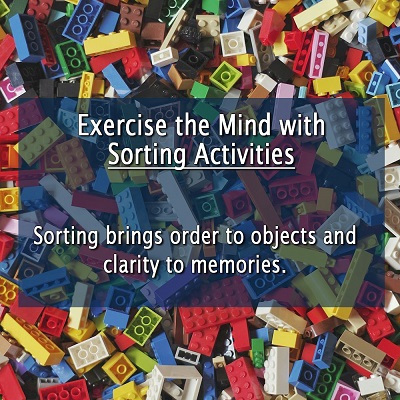 What are sorting activities? It sounds like something you have to do when sorting the washing and pairing up the socks! Come to think of it, that could be a good ‘game’ and make wash day more fun.
What are sorting activities? It sounds like something you have to do when sorting the washing and pairing up the socks! Come to think of it, that could be a good ‘game’ and make wash day more fun.
However, in all seriousness, sorting activities are excellent, gentle exercises for the brain. They don’t require memorization or quick thinking, but they do encourage focus, organization, and sensory engagement.
For anyone facing memory challenges or dementia, sorting activities can be calming and rewarding, offering a way to reconnect with the familiar rhythm of organizing things by color, shape, size, and even texture.
Sorting Activities to Try
Here are a few sorting activities that are not only simple to set up but can also spark curiosity, joy, and hopefully some memories.
Color Sorting
Color sorting is a fun, visual activity that can be done with many sorts of items. You can use whatever you choose! Start with a selection of objects in various colors. Place the objects in a container or tray, then set out bowls or sections labeled with different colors.
Simply have them start sorting the items by color, putting all the reds in one section, blues in another, and so the colors go on! If some colors are harder to differentiate, you can reduce the number of color options, or just remove them so they don’t get stressed by feeling like they don’t know.
Shape Sorting
Sorting by shape is another way to keep their mind engaged. Again, you can use all sorts of items.
Gather up items in various shapes, such as circles, squares, and triangles. You could use children’s blocks, household items, or make some paper shapes. Have them sort them into piles or containers based on their shape.
This activity brings in an extra challenge because it requires recognizing different outlines and distinguishing one form from another. This helps sharpen spatial awareness and provides a nice contrast to color sorting.
It can even be the next step in the activity for them. They can start with colors and then go on to shapes.
Sorting by Size
Sorting by size can also be fun, especially if you use items that are visually similar but vary in size. It’s a little puzzle in itself and helps them with recognizing patterns and order.
You can pick a few types of objects with varying sizes, like nesting bowls, or small and large buttons, or different-sized blocks. Have them arrange the items from smallest to largest, or group them into categories like small, medium, and large.
Sorting by Texture
For a sensory twist, sorting by texture is a wonderful option. Gather materials with a variety of textures like fabric scraps, cotton balls, or small pieces of wood. You can also use sensory items, such as rough sandpaper or soft felt. Be mindful though, as some people have sensitivities to certain textures. So don’t choose textiles that are upsetting to them.
To set this activity up, place the items in a basket, then ask them to group them by texture, such as soft, rough, smooth, etc. Encourage them to touch each item and describe the texture before placing it in a group. Also, ask them if it reminds them of anything. For example, a baby blanket can bring all sorts of memories!
Another important point to make here is that texture sorting, being a sensory experience, doesn’t require visual focus, making it ideal for individuals with visual impairments.
Food Sorting
This sounds like a yummy game, doesn’t it? Well, you can certainly make it one if you want to. Sorting food items, like pasta shapes, or dried fruits and nuts, can be a fun and familiar activity, especially for those who enjoy cooking or have fond memories of preparing meals.
You can get a few different types of food items and mix them all up in a bowl. Set up small dishes or containers for sorting into. Then they can start sorting by item type. Pasta shape one in this bowl, pasta shape two in the next one, etc. They can even sort by color or size if there’s variety.
Sorting activities are wonderfully adaptable. There’s no right way or wrong way, which means there’s a world of possibilities to try! They’re also easy to adjust to suit anyone’s level of memory ability.
For some, sorting by color might be engaging, while others may enjoy the challenge of sorting by shape or size. Watch them to see what makes them the happiest and what ones bring back loving memories the most.
Who knows, perhaps sorting their mother’s button collection may bring back very old memories that help them emotionally.






